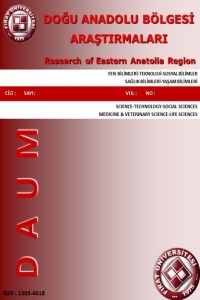MOSFET KONTROLLÜ BİR KIYICI DEVRESİNİN ANFIS İLE MODELLENMESİ VE TAM ÇÖZÜMÜ
ANFIS, MOSFET, Anahtarlamalı Devreler, Durum Matrisleri, Kontrol Eşitsizlikleri
___
- 1. M. Köksal ve Y. Tokad, “On the Solution of Linear Circuits Containing Periodically Operated Switches”, Proc. European Conf. on Circuits Theory and Design, Genoa, Italy, vol. 1, 1976, pp. 77-82.
- 2. D. Bedrosioan ve J. Vlach, “Time Domain Analysis of Network With Internally Controlled Switches”, IEEE Trans. on Circuit and Systems, vol. 11, no. 1, pp. 249-252, 2000.
- 3. M. Köksal, “A Fast Convergent Method for the Analysis of Nonlinear Systems with Periodic Excitations”, IEEE Int. Symp. On Circuit and Syst. Proc., vol. 3-3, Montreal-Canada, 1984, pp. 1362-1364.
- 4. Y. Demir, M. Köksal ve S. Herdem, “State-Space Suitable Modelling of Power Semiconductors with Ideal Switches, Resistors, Constant Voltage and Current Sources”, ELECTRIMACS’96, France, 1996, pp. 97-102.
- 5. M. Rewieński and J. White, Model order reduction for nonlinear dynamical systems based on trajectory piecewise-linear approximations Linear Algebra and its Applications, In Press, Corrected Proof, Available online 23 March 2005
- 6. P. Aruna, N. Puviarasan and B. Palaniappan An investigation of neuro-fuzzy systems in psychosomatic disorders Expert Systems with Applications, Volume 28, Issue 4, May 2005, Pages 673-679
- 7. T. atayapun and S. U. Atrongjit, Adaptive controller with fuzzy rules emulated structure and its applications Engineering Applications of Artificial Intelligence, In Press, Corrected Proof, Available online 14 March 2005,C.
- 8. C. J. Lin, and C.H. Chen, Identification and prediction using recurrent compensatory neuro-fuzzy systems Fuzzy Sets and Systems, Volume 150, Issue 2, 1 March 2005, Pages 307
- 9. R. Stathacopoulou, G. D. Magoulas, M. Grigoriadou and M. Samarakou, Neuro-fuzzy knowledge processing in intelligent learning environments for improved student diagnosis Information Sciences, Volume 170, Issues 2-4, 25 February 2005, Pages 273-307
- 10. C. Hung. Lee and Y. Ching. Lin, An adaptive neuro-fuzzy filter design via periodic fuzzy neural network Signal Processing, Volume 85, Issue 2, February 2005, Pages 401-411
- 11. S.C. Sinha, E. Gourdon and Y. Zhang, Control of time-periodic systems via symbolic computation with application to chaos control Communications in Nonlinear Science and Numerical Simulation, Volume 10, Issue 8, December 2005, Pages 835-854
- 12. Demir Y., 1993, Lineer Olmayan Devrelerin Durum Denklemlerinin Değişik Bölgelerde Bulunması ve Bölgeler Arası Geçişler İçin Anahtarlama Denklemlerinin Hesaplanması, Doktora Tezi, Fırat Üniversitesi Fen Bilimleri Enstitüsü, Elazığ, 206s.
- 13. S. Herdem, M. Köksal ve Y. Demir, “State-Space Steady-State Analysis of Electrical Systems with Strongly Nonlinear Components”, XV Sym. Electromagnetic Phenomena in Nonlinear Circuits, Belgium, 1998, pp. 233-236
- 14. Tuntaş R., 2005. Bulanık ve Sinirsel Ağ Yakla-şımlarıyla Anahtarlamalı Sistemlerin Analizi, Doktora Tezi, Fırat Üniversitesi Fen Bilimleri Enstitüsü, Elazığ.
- ISSN: 1303-4618
- Başlangıç: 2002
- Yayıncı: Fırat Üniversitesi
KÖPEKLERDE DENEYSEL DİSTAL EKSTREMİTE YARALARININ POŞ FLEP İLE SAĞALTIMI
KAPAKLI KONDUİTLERDE BOY UZUNLUĞUNUN HAVALANDIRMA PERFORMANSINA ETKİSİ
Mehmet ÜNSAL, Mehmet TUĞAL, Fahri ÖZKAN
Fulya BENZER, Necla ERKAL, Mine ERİŞİR, Turhan TURAN
GIDALARDA Yersinia enterocolitica’NIN MEVCUDİYETİ VE YERSİNİOSİS
FARKLI YÜK KOŞULLARINDA KLASİK DENETLEYİCİ PERFORMANSLARININ KARŞILAŞTIRILMASI
FUTBOLUN TOPLUM ÜZERİNE ETKİSİ
TÜRKİYENİN SPORDAKİ KONUMUNUN BAZI AVRUPA ÜLKELERİ İLE KARŞILAŞTIRILMASI
Mehmet Fatih KARAHÜSEYİNOĞLU, Fikret RAMAZANOĞLU, Eyyub NACAR, Oğuz RAMAZANOĞLU, Oğuzhan ALTUNGÜL
MALZEME VE GEOMETRİK BAKIMDAN LİNEER OLMAYAN ÇOK KATLI UZAY ÇERÇEVELERİN ANSYS İLE OPTİMİZASYONU
PEYAMİ SAFA’NIN ROMANLARINDA İSİM SEMBOLİZASYONU
HAVA KAYNAKLI ISI POMPASININ ELAZIĞ ŞARTLARINDA KULLANIMININ DENEYSEL OLARAK ARAŞTIRILMASI
